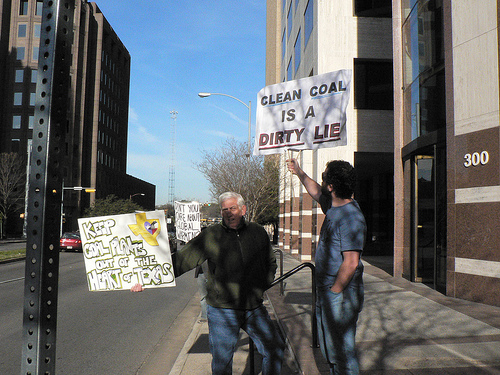 Good mooooooorning Texas! Just woke up, haven’t even gotten out of my pajamas or had my coffee (okay, I’m running a little late), but I couldn’t wait a moment longer to spread the good news. We’ve hit the big Times.
Good mooooooorning Texas! Just woke up, haven’t even gotten out of my pajamas or had my coffee (okay, I’m running a little late), but I couldn’t wait a moment longer to spread the good news. We’ve hit the big Times.
Yes, that Times. The New York Times.
Check out the following post from Kate Galbraith at the New York Times Green, Inc blog. Look for cameos by our very own David Power, Rep. Mark Strama, and the Austin Solar Plant.
TEXAS AIMS FOR SOLAR DOMINANCE
The Lone Star State leads the country in wind-power. Now Texas aims to ramp up its solar production too.
This week the state senate is considering an avalanche of bills that would boost state incentives for solar power, and the entire legislative session has become known as the “solar session.”
Altogether, according to David Power, the deputy director of Public Citizen Texas, a consumer and environmental advocacy group, there are 69 renewable energy bills before the legislature, and over 50 of them promote solar power – far more than ever before.
“There are senators and representatives that are talking about solar that have never mentioned the word probably in their lives,” he said. “We’ve actually heard the term ‘global warming,’ and two years ago that was called ‘the G word’ – you didn’t talk about it.”
Mark Strama, a state representative who is a leading promoter of renewable energy, has introduced at least five green bills this year (including a measure that would allow local governments to create a property tax financing program for solar, along the lines of several California cities).
“It just seems like everybody recognizes our leadership in wind, and that government policy got us where we are today in wind,” he told me last month.
In solar, he added, “We need to catch up.”
Some businesses, concerned about higher energy prices, urge caution.
“The state should avoid picking economic winners and losers in our economy through subsidizing solar – or any energy source – at the expense of the residential, commercial and industrial consumers who contribute significantly to the Texas economy,” said Luke Bellsynder, the executive director of the Texas Association of Manufacturers, in an e-mail message.
He also said, however, that his group supported incentives and tax abatements for solar, and broadening the state’s energy portfolio.
Earlier this month, the city of Austin, which is aggressively pursuing renewable power, unanimously gave a go-ahead to a private company to build the largest photovoltaic plant in the country, so that the local utility, Austin Energy, can buy the electricity produced.
However, the city met fierce opposition from struggling local technology firms and other groups, who complained about the prospect of higher electric bills.



 Last Friday two administrative law judges refused to hear testimony on the impact of carbon dioxide emissions during the permitting process for the NRG Limestone coal-fired power plant. The contested case hearing for NRG’s air quality permit application will be going on all week long, but testimony on the proposed plant’s contribution to global warming will not be allowed. The judges decided that the TCEQ has adopted clear policies that they would not consider testimony on the issue, even though the Supreme Court ruled in 2007 (
Last Friday two administrative law judges refused to hear testimony on the impact of carbon dioxide emissions during the permitting process for the NRG Limestone coal-fired power plant. The contested case hearing for NRG’s air quality permit application will be going on all week long, but testimony on the proposed plant’s contribution to global warming will not be allowed. The judges decided that the TCEQ has adopted clear policies that they would not consider testimony on the issue, even though the Supreme Court ruled in 2007 ( In protest, local environmentalists gathered for an 8:30 a.m. protest Monday Feb 22 outside the State Office of Administrative Hearings. Groups supporting the protest included: Public Citizen, SEED Coalition, Environment Texas, Clean Water Action, Re- Energize Texas, and the Texas Climate Emergency Campaign.
In protest, local environmentalists gathered for an 8:30 a.m. protest Monday Feb 22 outside the State Office of Administrative Hearings. Groups supporting the protest included: Public Citizen, SEED Coalition, Environment Texas, Clean Water Action, Re- Energize Texas, and the Texas Climate Emergency Campaign.





